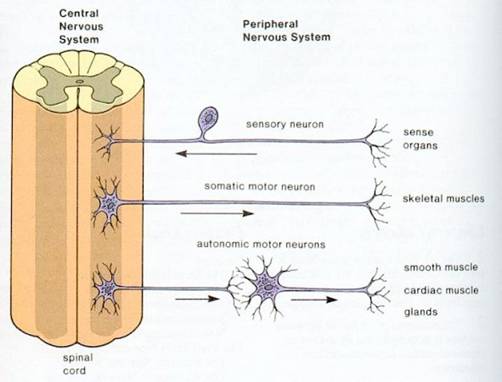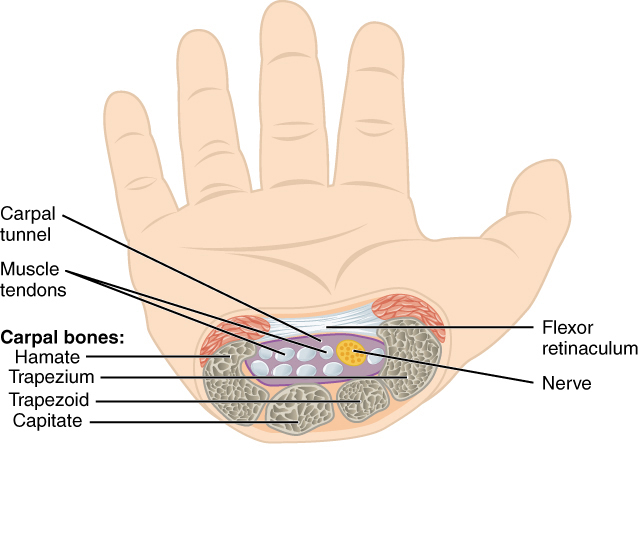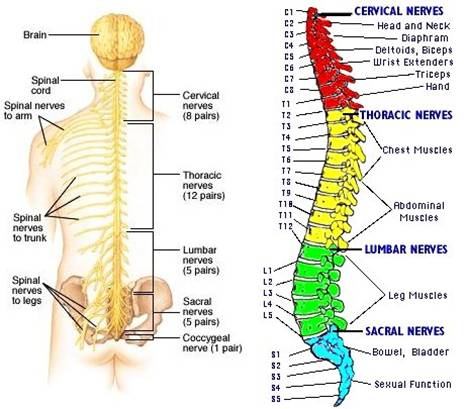Peripheral Neuropathy (PN) is damage to nerves affecting brain communication with our body

Peripheral nerves branch out of the spinal cord to all parts of the body, providing communication pathways between the central nervous system (CNS), i.e. the brain and spinal cord, and the muscles, skin, internal organs, and blood vessels. Damage to this communication network can cause the equivalent of static on a phone line and is called peripheral neuropathy or neuropathy.
See Peripheral nervous system 101 for some simple, informative diagrams
Damage specifically occurs to axons or myelin surrounding peripheral nerves. The axon is the “fiber-optic cable” of a neuron for transmitting messages from its neuron body (soma) to make contact with other cells – usually neighboring neurons but sometimes muscle or gland cells.

Types of peripheral neuropathy
(1) Motor (efferent) neuropathy. Affects nerves sending messages from the brain for voluntary / conscious control of muscles for movement (part of the somatic nervous system (SNS) )
Damaged motor nerves may:
- Impair movement and can lead to muscle weakness / wasting or even paralysis
(2) Sensory (afferent) neuropathy. Also part of the SNS, it affects nerves that receive and transmit sensations from parts of the body to the brain, E.g. heat, pain or touch.
Damaged sensory nerves may:
- Stop relaying signals. Resulting in numbness and pain (most often in hands and feet)
- Send incorrect signals. Transmitting sensations of pain, burning or tingling sensations (sometimes described as “pins and needles”)
(3) Autonomic neuropathy. Controls subconscious (involuntary) functions of sensory and motor nerves affecting body’s housekeeping of such as blood pressure, heart rate, digestion and bladder function; (part of the autononic nervous System (ANS) )
Damaged autonomic nerves may:
- Impair any involuntary function – depending on location of damage, and can be serious.
PN commonly starts in the longest nerves. i.e. those going to your toes;
PN may affect one to several nerves:
- Mononeuropathy. 1 nerve;
- Multiple mononeuropathy. 2 or more nerves in different areas;
- Polyneuropathy. Many nerves.
Neuropathy is also classified by its cause or location – these include:
- Diabetic neuropathy
- Nutritional neuropathy
- Radiculopathy. Neuropathy resulting from pressure on / injury to a spinal nerve root (Radix) affecting nerve function. Radicular pain and other symptoms (weakness, numbness, pins and needles, lack of muscle control) may manifest as “referred” pain / symptoms in an extremity. E.g. Impingement in the lower back can result in pain/symptoms in the foot. Radiculopathy may be experienced in such as herniated disk, spinal stenosis (narrowing of spinal canal), sciatica and degenerative disk disease;
- Entrapment neuropathy. Occurs when inflammation of connective tissue puts pressure on a nerve passing through it;
- Idiopathic neuropathy. When a cause cannot be identified;
Symptoms of peripheral neuropathy (PN)
Symptoms vary depending on type of nerves affected and may include:
- Gradual onset of numbness and tingling in feet or hands. May spread upward into your legs and arms;
- Burning / Searing pain. Especially at night, when it can seriously disrupt ability to sleep;
- Sharp, jabbing or electric-like pain;
- Extreme sensitivity to touch. Even light touch;
- Lack of coordination;
More severe cases experience:
- Muscle weakness / wasting or paralysis, if motor nerves are affected;
- Autonomic nerve dysfunction (Organ / gland dysfunction).
With an inability to:
- Swallow / digest food properly and / or control bowel function. Lack of esophageal or intestinal muscle control (possibly manifesting as diarrhea or constipation)
- Maintain healthy blood pressure. Lack of arterial muscle control for contraction/dilation -experienced as dizziness, lightheadedness, or even fainting when a person moves suddenly from a seated to a standing position;
- Control bladder function. Lack of bladder muscle control can cause incontinence or lead to infection.
- Sweat normally
- Have normal sexual function
Causes of neuropathy nerve damage / inflammation
Numerous factors can cause neuropathies
Neuropathies affect at least 20 million people in the U.S. All forms of neuropathy involve inflammation as a result of damage from: Autoimmune diseases. E.g. Lupus, rheumatoid arthritis and Guillain-Barre syndrome. Some neuropathies are caused by inflammation resulting from immune system activities, and can develop quickly or slowly.- Acute inflammatory demyelinating neuropathy (aka Guillain-Barre syndrome). Can quickly damage motor, sensory, and autonomic nerve fibers; Most people recover from this syndrome although severe cases can be life threatening.
- Chronic inflammatory demyelinating polyneuropathy. Usually damages sensory and motor nerves, but not autonomic nerves; can alternate between remission and relapse.
- Acute or chronic multifocal motor neuropathy. Affects only motor nerves.
- Heavy metals. E.g. arsenic, lead, mercury, thallium; Magnesium deficiency allows heavy metal deposition in the brain.
- Certain medications. Certain anti-cancer drugs (especially chemotherapy), anticonvulsants, antiviral agents, and antibiotics.
- Environmental toxins
BACTERIA / VIRUS |
ASSOCIATED DISEASE |
| Borrelia burgdorferi (spirochete bacteria) | Lymes Disease – rapidly developing, painful polyneuropathy, often within a few weeks after initial infection by a tick bite. |
| Corynebacterium diphtheriae | Diphtheria |
| Mycobacterium leprae/lepromatosis | Leprosy |
| Varicella-zoster | Shingles – Postherpetic neuralgia occurring after an attack of shingles |
| Epstein-Barr virus | Epstein-Barr |
- Motor vehicle accidents
- Falls
- Sports injuries
- Slipped disks between vertebrae
- Broken/dislocated bones
- Using a cast or crutches / Spending a long time in an unnatural position
- Repetitive Stress /Repeating a motion many times (E.g. typing) – repetitive flexing of any group of joints for prolonged periods often leads to entrapment neuropathies, by causing ligaments, tendons, and muscles to become inflamed and swollen, constricting the narrow passageways through which some nerves pass. E.g. Carpal tunnel syndrome
- A pinched nerve in the back
- Tumors. Growths can form directly on the nerves themselves, or tumors (malignant and benign) can exert pressure on surrounding nerves contributing to PN;
- B1 deficiency is typically seen in alcoholics
- There are several causes of B12 deficiency:
A strict vegetarian diet. Since animal-based foods such as red meat, dairy products, fish, poultry and eggs are the only recognized source of dietary B12.
Inability of stomach acids to aid in B12 absorption. As such, drugs taken to reduce stomach acid should be taken with B12 supplements.
Other conditions/procedures associated with a reduced ability to absorb B12. Include autoimmune diseases, pernicious anemia, pancreatic diseases, ileal resection, Crohn’s disease, HIV infection, gastritis, gastric or small intestine surgeries, malabsorption syndromes, M.S.
Kidney disease, liver disease. By allowing abnormally high amounts of toxic substances in the blood that can severely damage nerve tissue. Most patients on dialysis because of kidney failure develop polyneuropathy. Reduced oxygen supply to peripheral nerves. Hypoxia caused by vascular damage or diseases of the blood can seriously damage or kill nerve tissue. Blood flow is impeded as blood vessels become inflamed, which reduces lumen size as vessel walls harden, thicken, and develop scar tissue. Blood vessel constriction is often present with diabetes. Hormonal imbalances. Can disturb normal metabolic processes and cause neuropathies.- Underproduction of thyroid hormones (Hypothyroidism). Slows metabolism, leading to fluid retention and swollen tissues that can exert pressure on peripheral nerves.
- Overproduction of growth hormone. Can lead to acromegaly, a condition where many parts of the skeleton become abnormally enlarged. Nerves running through enlarged joints can become entrapped.
- Estrogen neuropathy. In women, neuropathy can start within a decade of approaching menopause. Search for: “Estrogen Neuropathy”, “Menopause Neuropathy”, “Hypothyroidism Neuropathy”
M Hadjivassiliou et al, Sensory ganglionopathy due to gluten sensitivity. Neurology. 2010 Sep 14;75(11):1003-8. PubMed
M Hadjivassiliou et al, Neuropathy associated with gluten sensitivity. J Neurol Neurosurg Psychiatry. 2006 Nov;77(11):1262-6. Epub 2006 Jul 11. PubMed
















